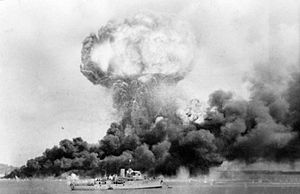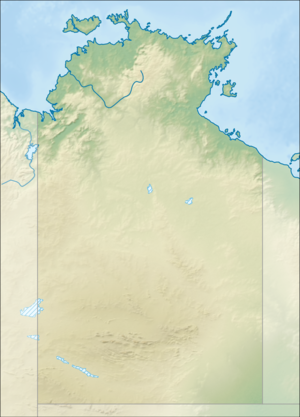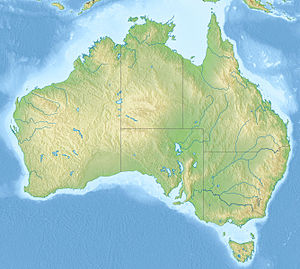
Back قصف داروين (فبراير 1942) Arabic Бомбардировка на Дарвин Bulgarian Bombardeig de Darwin Catalan Nálet na Darwin Czech Bombningen af Darwin Danish Luftangriff auf Darwin German Bombado de Darvino Esperanto Bombardeo de Darwin Spanish بمباران داروین Persian Darwinin pommitus Finnish
| Bombing of Darwin | |||||||
|---|---|---|---|---|---|---|---|
| Part of the Pacific War | |||||||
 The explosion of MV Neptuna, filled with TNT and ammunition, hit during the first Japanese air raid on Australia's mainland, at Darwin on 19 February 1942. In the foreground is HMAS Deloraine, which escaped damage. | |||||||
| |||||||
| Belligerents | |||||||
|
|
| ||||||
| Commanders and leaders | |||||||
|
|
| ||||||
| Strength | |||||||
|
31 aircraft 18 antiaircraft guns 1 destroyer 1 seaplane tender 2 sloops 4 minesweepers/corvettes 4 boom defence vessels 9 merchant ships/transports 1 hospital ship 23 auxiliary vessels 12 pearling luggers |
242 aircraft (188 carrier-based aircraft; 54 land-based medium bomber aircraft) 4 aircraft carriers 2 heavy cruisers 1 light cruiser 7 destroyers 3 submarines | ||||||
| Casualties and losses | |||||||
|
236 killed[1][2] 300–400 wounded 30 aircraft destroyed[1] 11 vessels sunk 3 vessels grounded 25 ships damaged |
Four carrier aircraft lost 2 killed[3] 1 POW 34 carrier aircraft damaged[1] | ||||||
Location within Northern Territory | |||||||
The Bombing of Darwin, also known as the Battle of Darwin,[4] on 19 February 1942 was the largest single attack ever mounted by a foreign power on Australia.[5] On that day, 242 Japanese aircraft, in two separate raids, attacked the town, ships in Darwin Harbour and the town's two airfields in an attempt to prevent the Allies from using them as bases to contest the invasion of Timor and Java during World War II.
Darwin was lightly defended relative to the size of the attack, and the Japanese inflicted heavy losses upon Allied forces at little cost to themselves. The urban areas of Darwin also suffered some damage from the raids and there were a number of civilian casualties. More than half of Darwin's civilian population left the area permanently, before or immediately after the attack.[6][7]
The two Japanese air raids were the first, and largest, of more than 100 air raids against Australia during 1942–1943. The event happened just four days after the Fall of Singapore, when a combined Commonwealth force surrendered to the Japanese, the largest surrender in British history.
- ^ a b c Cite error: The named reference
ReferenceAwas invoked but never defined (see the help page). - ^ "Northern Territory Library | Summary of Roll of Honour". Ntlexhibit.nt.gov.au. 19 February 1942. Archived from the original on 20 December 2019. Retrieved 26 September 2013.
- ^ Takezo Uchikado and Katsuyoshi Tsuru were killed when their Val dive bomber crashed near Darwin. Hajime Toyoshima was taken prisoner when his Zero crashed on Bathurst Island. The Zero of Yoshio Egawa and the Val dive bomber of Takeshi Yamada and Kinji Funazaki, ditched upon returning to the carriers.
- ^ "Bombing of Darwin: 70 years on – ABC News (Australian Broadcasting Corporation)". Abc.net.au. 8 February 2016.
- ^ "Bombing of Darwin". City of Darwin. 2023. Retrieved 17 February 2023.
- ^ "The bombing of Darwin – Fact sheet 195 – National Archives of Australia". Naa.gov.au. Archived from the original on 26 April 2018. Retrieved 19 February 2014.
- ^ Cite error: The named reference
Grose_2was invoked but never defined (see the help page).


